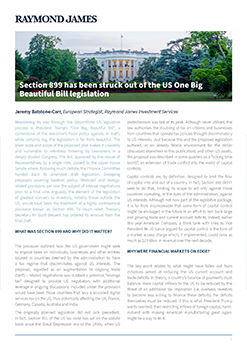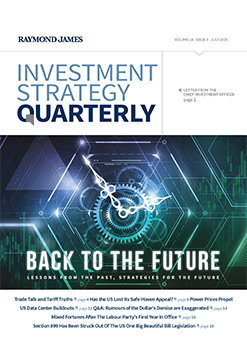With US tariff negotiations still featuring heavily in the news, Raymond James European Strategist, Jeremy Batstone-Carr, considers recent developments and their potential effects on the global economy.
Section 899 has been struck out of the US One Big Beautiful Bill legislation
Investment Strategy Quarterly – July 2025
Our latest Investment Strategy Quarterly considers the complexities of today’s markets while drawing insights from the past. This edition includes the historic and current impact of tariffs, asks if the US still holds its safe-haven appeal for investors, and examines energy costs and AI. Closer to home, we take a look at Labour’s first year in office.
Flexible ISAs
Flexible ISAs are not new products; they’re a new way in which some ISAs work. In a nutshell, with a flexible ISA you can take money out of your cash ISA and return it in the same tax year without reducing your annual allowance. Flexible ISAs will become “flexible” automatically – you don’t need to do anything in order to get the additional benefits of flexible withdrawals and payments. Both variable and fixed rate cash ISAs can become flexible ISAs – although not all flexible ISA providers offer flexibility on all their products.Continue reading
Inheritance ISAs
Inheritance ISAs are aimed at people whose partners had an ISA at the time of their death. The value of their combined ISA accounts at the time they died is added to your own ISA allowance. For example, if your partner had £20,000 in ISAs when they passed away, you would receive an additional ISA allowance of £20,000, giving you a total allowance of £40,000. Inheritance ISAs are available to anyone who has lost a husband, wife or civil partner since December 3, 2014. The additional allowance is available for three years after your partner has passed away, or 180 days after the administration of the estate has been completed (whichever is the later date). You can’t replace any money you take out; you can only use up your remaining allowance and you may only register your inherited ISA allowance with one provider.Continue reading
Innovative Finance ISAs
The growing popularity of alternative savings and investments schemes, such as peer-to-peer loans and crowdfunding services, has led to the government creating a new ISA category: the Innovative Finance ISA. Launched in April 2016, innovative finance ISAs are a half-way house between a cash ISA, which is safe but yields a low return, and a stocks and shares ISA, which offers more reward but carries far greater risk. Put simply, innovative finance ISAs enable you to lend out your own money – a bit like being your own bank manager.Continue reading
Help to Buy ISAs
Another option for first-time buyers saving for a mortgage deposit is a help to buy ISA. With a help to buy ISA you can earn up to 2.27%interest tax free, and the government will add 25% tax free to whatever is in your ISA when you use it to buy a home. However, the bonus will only be available on homes costing under £250,000 (£450,000 in London). In addition, although you can use the help to buy ISA with any type of mortgage (not just a help to buy mortgage), it must be a residential mortgage and not buy-to-let.Continue reading
Lifetime ISAs
Launched in April 2017, the lifetime ISA is a government initiative to encourage people to save for their first home or their retirement. For every £4 you save, the government will add £1 (worth up to £1,000 a year) paid at the end of each tax year, up to the age of 50. Up to £4,000 a year is eligible for the government bonus, with the government adding a 25% bonus (up to £1,000 each year) on any contributions made before your 50th birthday.Continue reading
Junior ISAs
There are a number of different ways for parents to invest and save for their children, and one of the most popular ways is by putting money into a Junior ISA. Unlike standard accounts (where any income or savings investment above £100 per year from money derived from either parent is taxable at that parent’s tax rate), Junior ISAs offer a tax-free way for parents to save for their children up to the age of 18. The annual limits are much lower than on the basic cash ISA: at present, no more than £4,080 can be put into a Junior ISA each tax year.Continue reading
Stocks & Shares ISAs
If you don’t mind taking a few risks with your money and you have the time to ride out any market fluctuations, putting some money into a tax-efficient stocks and shares ISA could be a smart move. There’s a huge range to choose from, and you don’t even have to invest in stocks and shares – you can invest in bonds, government gilts, commercial property and even commodities such as gold.Continue reading
Cash ISAs
It’s estimated that 80% of the 12.5 million ISAs that have been opened are cash ISAs, and there’s a very good reason why they’re so popular: with a cash ISA, you don’t pay tax on the interest you earn. This makes cash ISAs an attractive option for anyone who normally pays tax on their savings, and it’s one of the main reasons why they’re the best way for most people to save money. And although the new Personal Savings Allowance (PSA) means that all basic rate taxpayers will now earn £1,000 interest from all savings without being taxed on it, cash ISAs are still worth considering as the cash saved within them will be tax-free indefinitely.Continue reading












